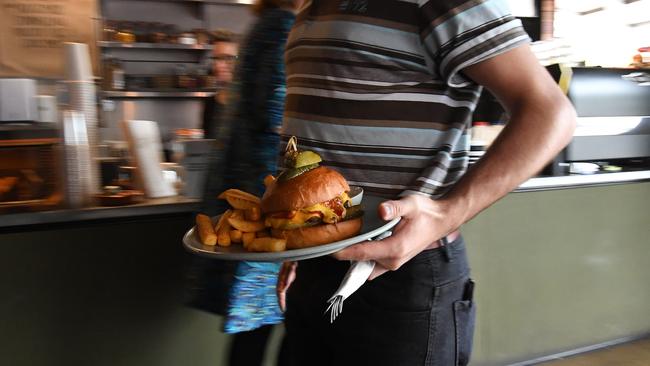Minimum wage gains larger under Coalition rule, analysis reveals
Wages for Australia’s lowest paid workers have fallen in real terms through Labor terms of government over the past four decades, and have climbed under the Coalition.

Wages for Australia’s lowest-paid workers have fallen in real terms through Labor terms of government over the past four decades, and have climbed under the Coalition.
Analysis by The Australian reveals that, since Bob Hawke became prime minister in 1983, inflation-adjusted wages for those earning the lowest minimum rate have fallen on average by 0.7 per cent a year under Labor. By contrast, they have risen on average by 1 per cent through the two periods of Coalition rule.
The Albanese government last week accused the opposition of presiding over a “decade of deliberate wage stagnation” – a favourite line of attack that ignores wages grew faster than inflation through the last Coalition term.
The findings need to be placed within the economic context of the past 40 years, experts said, and come after Labor once again pushed the Fair Work Commission to deliver a minimum pay rise aimed at ensuring that “the real wages of Australia’s low-paid workers do not go backwards”.
The ACTU and the Australian Chamber of Commerce and Industry have made claims of 5 per cent and 2 per cent, respectively.
Jim Chalmers revealed new analysis over the weekend showing that average weekly ordinary full-time earnings were running at $98,217.60 per year – an increase of $119 a week since the Albanese government came to office. The Treasurer said a worker on that wage would also receive a tax cut of $2134.33 from July 1.
“We’ve seen real wage growth return ahead of schedule and the government’s policies have helped deliver that growth for workers, sooner,” Dr Chalmers said. “It’s not mission accomplished, but under Labor wages are growing, inflation is slowing and from July 1 our tax cuts will flow as well.”
Employment Minister Tony Burke said Labor had succeeded in getting wages moving again by “securing record increases to awards and minimum pay, backing and funding a 15 per cent pay rise for aged care workers, modernising the bargaining system, and closing loopholes that were undercutting pay and conditions.”
Speaking in parliament last week, Dr Chalmers said Labor was “the party of working people”.
“We support Australians on the minimum wage. We know that wages growth is best when it’s bottom-up and not just top-down. Our approach is very different to theirs (the Coalition), it must be said. For a decade, a deliberate design feature of their economic policy was to keep wages low.
“We want people to earn more and keep more of what they earn. Those opposite want people working longer for less. The difference is very, very clear.
“You’ll see it in our submission to the Fair Work Commission. We are here for working people. Those opposite never were, and they never will be.”
Independent economist Chris Richardson said the claim of “deliberate wage suppression” under the Coalition was “not true”.
“What would be the point of taking money away from the vast bulk of workers?” Mr Richardson said. “What politicians say about each other – in either direction – should be given very little weight.”
The Australian’s analysis shows the real minimum wage lifted at an average annual rate of 0.8 per cent under Tony Abbott, Malcolm Turnbull and Scott Morrison between 2014 and 2021. This matches the equivalent average annual increase in the first two years of the Albanese government – although an inflation-matching rise in 2024 would lower that average figure to 0.5 per cent.
Under John Howard, between 1996 and 2007 real minimum wages rose at an average annual pace of 1 per cent, and then by 0.3 per cent under Labor leadership between 2008 and 2013.
The fastest annual decline of 1.4 per cent was during the Hawke and Keating governments, based on wage decisions between 1983 and 1995. Since the early 1980s, Labor governments have been in power during periods of surging inflation, which in large part explains the relatively poor record revealed in the data.
Professor Peter Whiteford at the ANU’s Crawford School of Public Policy said given the historical and economic context, he wasn’t surprised that the real minimum wage had tended to fall under Labor governments.
“When Hawke came in there was that big concern over the so-called ‘real wage overhang’ following the wage explosion in ’81 and ’82. So the Accord (between Labor and unions in 1983) was all about constraining real wages,” Professor Whiteford said.
“So for Hawke and Keating, it was in the particular context that they were elected as the recession was deepening,” he said.
“The arguments they gave for constraining real wages, apart from constraining unemployment, was improving the social wage. They reintroduced Medicare. Later in the ’80s there were massive rises in family payments.”
Melbourne University professor Mark Wooden, a FWC expert panel member in 2020, issued a rare dissenting opinion against that year’s 1.75 per cent increase to the minimum wage as Covid lockdowns triggered a surge in unemployment. He said the economic conditions demanded no rise.
Professor Wooden was also targeted by unions after saying publicly during the 2022 election that the last thing the panel needed was “governments telling us what to do”, and was dumped by the Albanese government in 2023 after serving only three years of his five-year term.
Professor Wooden told The Australian he believed there should “absolutely not” be any political pressure on the FWC to deliver a certain result. “It is supposed to be independent, like the Reserve Bank, and the government has the potential to influence it. Labor in opposition would talk about the importance of the independent umpire,” he said.






To join the conversation, please log in. Don't have an account? Register
Join the conversation, you are commenting as Logout